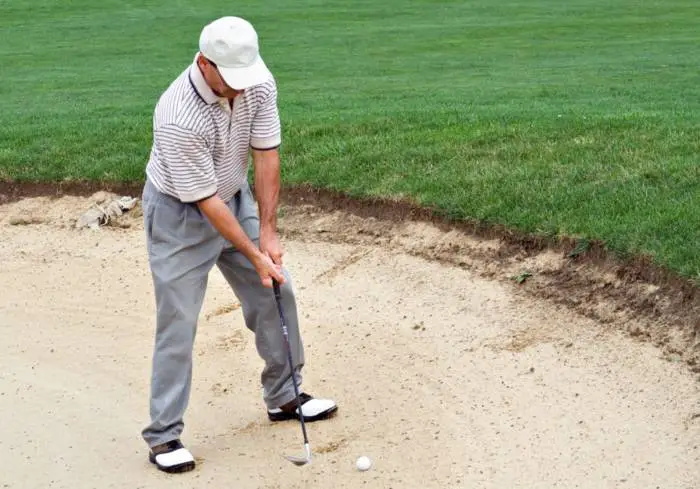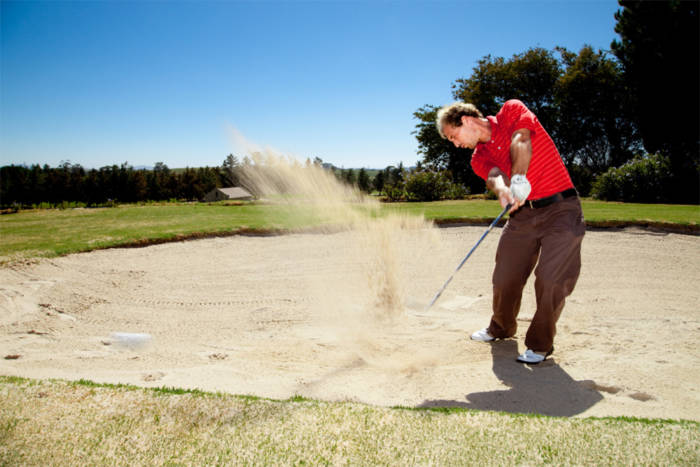How To Hit A Bunker Shot
The bunker shot is one of the most difficult techniques to master in golf, due to the challenging nature of the lie and the often extreme step up out of the bunker.
It’s embarrassing enough to land in a bunker, but getting out can be even more humiliating if you’ve not taken the time to perfect or at least grasp the fundamentals of escaping the sand.
That said, it’s not uncommon to land in this situation. While all of us aim to stay clear of this scenario, it’s sometimes unavoidable!
While it may seem just like any other shot, there are some key and specific details to hitting a good bunker shot. Not being aware of these could spell disaster for your hole or the round in its entirety.
However, if you do know your way around a sand wedge you’ll be able to salvage the situation quite easily.
How to get out of a bunker

Regardless of your handicap, in this guide, we’re going to look at how to hit a solid bunker shot to give you more confidence on your approach and a get out of jail card if the worst should happen!
If the worst comes to worst, you can always take a penalty drop. For that reason, it’s worth understand the golf rules when you’re in a bunker.
But without further introduction let’s take a look at the first steps.
1. Club choice

While it seems obvious, it’s worth mentioning that loft is key. You’ll almost always want to use a sand wedge (56 degree wedge or more) to hit a bunker shot.
In order to get the ball out with enough loft to clear the face of the bunker, you need the club to glide under the ball into the sand. The sand wedge loft is designed to give you the best chance of that happening.
Even if you choose a high lofted club you may want to add a little more loft by opening the clubface slightly.
If the green is flat and you execute the shot properly, the ball will hardly roll and should stop pretty quick. This should give you more control and better help judge the shot.
There may be very specific scenarios where an alternative club could be used. For example, if you don’t have a big lip to get over or you have plenty of green to work with between the bunker and flag, you could opt for a less loften club so you don’t have to swing as hard to get the ball out.
2. Stance

In order to escape a bunker, you’re going to need to swing the club wide and low to allow the club to glide under the ball and into the sand. There are a few important steps you can take to give yourself the best possible chance:
Wide stance – Unlike most approach or chip shots, a bunker shot requires a wide stance. The idea behind this is that you get as low to the sand as possible.
Stable base – Twist your feet into the sand to give yourself a more stable base. It also helps to get a feel for how deep the sand is and how the club is potentially going to react.
Weight on the front foot – You should place more of your weight onto your front foot and allow the front leg to bend slightly at the knee to take on this weight. This is required to give more stability and leverage as sand is a very uncooperative lie that saps most of the power you use to hit the ball and is unsteady underfoot.
Ball positioning – The ball should be in line with the heel of your front foot, meaning the ball will be further forward in the stance than on a standard shot. This helps you to get under the ball with your shot and get the ball out of the sand and the bunker more easily.
3. Shot preparation
Set the club so the face is behind the ball by 2 inches or so, and let the clubhead face the sky.
Pick out a small mark (or grain of sand) in the bunker here, as this is where you’ll actually want to hit when you make your swing. You don’t actually want to hit the golf ball, and want to make contact with the sand behind the ball.
If you try to simply hit the ball directly or chip it out of the bunker, you’ll likely thin the ball and make your situation worse.
When you swing you’ll want your club to be as open as it is when you address the ball, with the face being almost parallel to the sky as this will also help you deliver the club with most loft and give it the lift it needs to get out of the bunker.
4. Swing

The backswing is what will determine the power and distance of your shot, so you can adjust this according to how much power you need. This can take some practice, but eventually, you should get a good sense of how much juice you need depending on your situation.
The most important thing is to accelerate forward and commit fully to the shot on the downswing. Don’t slow down or stop once you reach the top of your backswing, commit forward again in a fluid motion.
Remember, you’re hitting the sand 1 to 2 inches behind the ball and not the actual ball itself. Once your club hits the sand, it’s going to slow your swing down, so you need enough momentum to see the shot through and get the ball out of the bunker.
Beware of hitting the sand too far behind the ball too, as you risk losing too much power and making a right mess of yourself and any chance of salvaging your hole.
Finally, remember to deliver the club to the ball with as much loft as possible. Avoid getting too far ahead of your hands and delofting the club. Play with the bounce of the club and keep the face open (pointing to the sky) as long as possible.
Don’t be afraid of spraying some sand with your follow-through, this is often the sign of a good and powerful bunker shot!